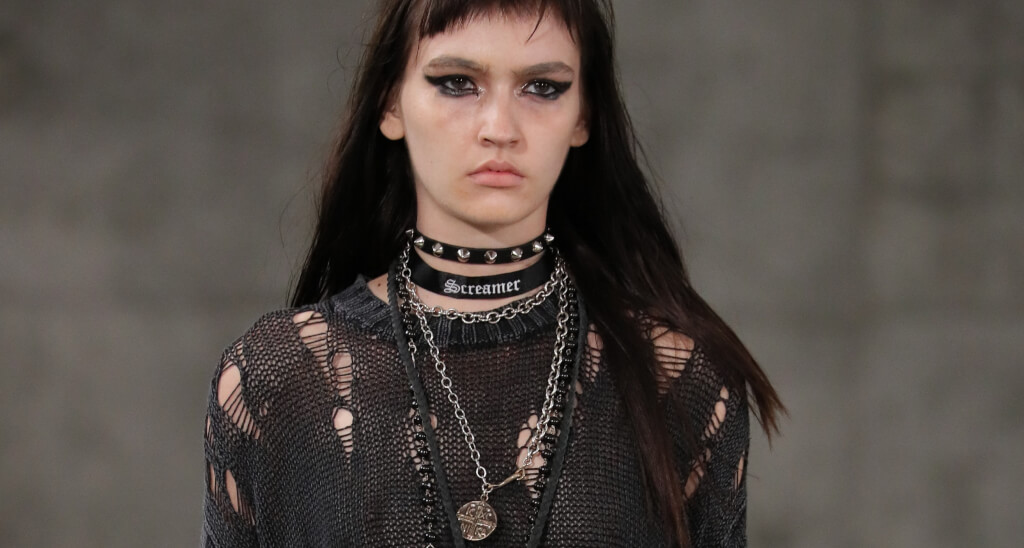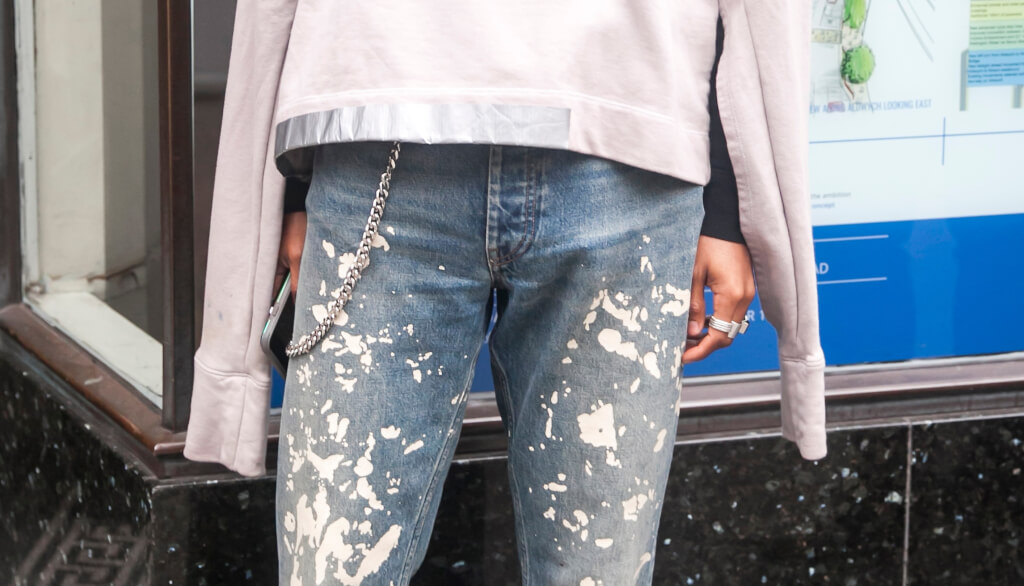Dirty chic: why the rich spend thousands of dollars on tattered and torn clothes
'19.12.2020'
Source: Lenta.ru
Those who saw the beginning of the 2000s already at a conscious age remember that then the object of desire was everything “glamorous”: sleek, sparkling, new and dotted with logos of fashion brands. Less than 20 years later, the trend has radically changed: the most famous luxury brands, celebrities and bloggers suggest wearing wrinkled, torn and stained clothes. How did the fashion for such things appear and why wealthy buyers are willing to spend thousands of dollars on a "bum" wardrobe, says Lenta.ru.

Labor dirt
In the spring of 2017, the premium brand PRPS put up for sale a model of Barracuda Straight Leg Jeans for men at a price of $ 425, which caused great surprise to potential buyers. There is no problem in the very fact of such a price: PRPS is an expensive brand. The problem was how the pants looked (and the proposed pair of denim jacket). Both were covered with a layer of mud. The mud looked dry in places and almost fresh in places, as if the owner of the clothes had just climbed out of a ditch or threw dung. It turned out that this was the plan: the creators of the novelty offered their customers to try on "the image of a person who is not afraid of dirty work."
A real trend has grown from a strange, even somewhat curious, creativity for fashionable city dwellers (hardly real workers want to wear $ 400 jeans that look like pants for working in a barn in their free time). Following niche and premium brands, "dirty", "crumpled" and "worn" things began to "indulge" and serious brands and fashion houses.
On the subject: Jeans and 6 more things from your closet that cannot be washed more than once a year
In addition to stains of dirt and paint, artificial holes in knitwear, creases and cracks in shoes, scuffs and stains on leather bags were used. All this was often more expensive than what visually looks brand new. In the fall-winter 2020-2021 season, the PRPC success of three years ago decided to repeat the super-popular luxury fashion house Gucci. His jeans with green "grass spots" cost not more than $ 400, but about $ 800. A year earlier, the same fashion house had deliberately soiled and worn sneakers for $ 870, and today - torn nylon tights for $ 200.

The trend is also being developed by premium brands: for example, in 2019, for the next anniversary of its legendary 501 model, Levi's launched a capsule collection with American designer Heron Preston. Preston spray-painted the jeans, making them look like a painter's overalls.
This is not to say that holes, stains of dirt and paint and other special defects in clothing and shoes are something completely new for fashion, which arose only in the late 2000s. Fashion critics, fashion experts and fashion industry insiders confidently draw parallels between deconstructivism in 1980-1990s fashion (shows by Rei Kawakubo, Yoji Yamamoto, Maison Martin Margiela) and modern trends.
“I love it all: the seams on the outside, the fabric inside out, frayed, torn edges, a worn look, an oblique cut when it’s not clear where the collar is and where the waist is. Everything that the French called deconstruction when they first saw the shows of Kawakubo and Yamamoto: Thank you very much for the revolution that they made. It seems to me that if they were not lucky to become the first, someone would have done it sooner or later, ”says designer Lena Kogan.
According to the designer, "torn chic" is an absolute metaphor of complete freedom and ease, "" beggar's clothes ", for which it is important to cover the body, not to expose it." She recalls that for the snob and dandy Oscar Wilde, casual dress was "an intolerable kind of ugliness." “But, fortunately, we live in a time when there is a choice and you don’t have to listen to those who know exactly what to do,” Kogan says.
What is the root cause of the trend? Who needed it and why, why did it arise? The most intriguing point of view on this issue is philosophical.
“This trend is a denial of correctness in favor of incorrectness. Perhaps this is a general denial of the previous norm. Like the abolition of corsets or deconstructivism in due time, - notes the stylist and fashion expert Alena Isaeva. - Now everything is in fashion from the street. Gosha Rubchinsky was from the same series, but he had everything “pseudolokhovskiy”, and now everything “homeless” is fashionable ”.
Grand ladies of the past carefully selected a handbag to match their shoes - not only in color, but also in the texture of leather or textiles. The corset tried to return to fashion back in the middle of the twentieth century (but the desire of women for the newly acquired freedom was stronger). For decades, monochrome ensembles, where everything - from shoes to gloves - exactly the same color, as in Melania Trump's inaugural look, was considered a sign of supreme elegance. It looks like it has decisively gone out of style now.
“Anything that is too perfect now seems unnatural, deliberate. Any desire to follow the rules is a sign of a lack of inner freedom. And freedom these days is the main value. If you allow yourself imperfection, then you are internally free, ”concludes Alena Isaeva.
However, not all fashion industry insiders are inclined to such deep philosophical generalizations at the sight of luxury clothes smeared with fake mud.
“About the“ torn-mint-dirty ”trend in the collections of expensive stamps, I always want to begin with a clever look to speculate about the deep socio-economic reasons for an alarming era. But I always end with a frivolous “I wanted variety”. After expensive cakes, you can grab a shawarma on the street, ”jokes designer and fashion historian, founder of Fashion Factory School Lyudmila Norsoyan.
Followed by Tumberg
Another curious version of the trend for new luxury items masquerading as dirty rags reminds us of the heroine of the ancestral news agenda - Greta Tumberg - and her calls to protect the planet from pollution by limiting consumption. According to this hypothesis, such things are bought by people who want to look progressive but will never go for swap or second-hand stores.
“Any local trends leave the global ones. The oversaturation of the market generated by the mass market nevertheless made itself felt. People sell their branded items en masse, leaving only the essentials, - reflects Olga Vasyukova, designer and creative director of the Russian brand Red September. “Some people sincerely support the eco-trend and dress in second-hand shops, while others will never go to secondhand, but want to be in trend.”
A fake for worn and unwashed clothes or an assortment of the Second Wind store performed by luxury brands is a kind of ideological fake for such a popular eco-trend. A sort of "pseudosecond" is expensive.
On the subject: Green clothing trend: 9 myths about ethical and sustainable fashion
Another version sounds completely postmodern. Ultra-popular fashion houses like Gucci or Balenciaga may not be releasing pseudo-seconds to seriously encourage shoppers to cheat on their environmental conscience, but rather to tease the trend, customers, or themselves. After all, self-irony is a sign of high intelligence.
The worse the better
Many young designers who enjoy reimagining the history of fashion and recycling vintage fabrics and other materials take the second-hand trend with great enthusiasm. In their performance, this is no longer new, suddenly becoming old, but old, creatively rethought and becoming new. Large brands have similar initiatives: for example, Uniqlo has repeatedly attracted designers-students of the Higher School of Economics, who created original collections from the converted clothing of this Japanese brand.
On the subject: No longer worn: 9 anti-trends of winter 2020/2021, with which it's time to say goodbye
Old and aged materials are of interest to many designers.
“I specifically choose skin with signs of aging. My accessory aesthetic is "the worse the better." Over time, new things "customize" - crumple, wear out. That is, they live, they change in a unique way, ”says Into Niilo, designer of the into [into] brand.
Nikita Kalmykov, the designer of the Odor brand, shares her point of view.
“When I recycle vintage materials - fabrics, lace - I leave traces of time on them: spots, tears. This is the history of things and the history of fabric. It is important to preserve it and it is important that the owner of this thing rethinks it and, perhaps, comes up with his own story: where was this shirt or was this lace before him? " - says Nikita.
In his opinion, the “pseudosecond” trend has arisen and is developing because buyers realized that things in the modern world must have a long life cycle - much longer than the one that the global mass market has taught us over the past twenty years.
“Tears and contamination are an integral part of any item wearing by any person, especially if he leads an active lifestyle. It is both commercially and design advantageous to make this a “feature” of the product. Previously, a person saw, say, some scuffs on the knees of jeans after wearing, became disappointed and bought new ones. And now he understands that it is such an accent that makes things original, ”says designer Nikita Kalmykov.
However, among progressive young designers, there are also supporters of an alternative approach: for example, those who are trying to “rejuvenate” vintage items and materials. So, Roma Uvarov, the designer of the Roma Uvarov Design brand, creates his things from the most real second-hand, like old blankets or Soviet soft toys made of synthetic fur. However, he believes that things should be “neat and tidy”, so all the “recyclable materials” he collects undergo a thorough dry cleaning and processing before turning into a new fashion collection.
No more dirty
Finally, dirty things are convenient in that they are not a pity to get dirty and can rarely be washed and not ironed at all. Even the most careless handling of such clothes and shoes will only make them even more original and trendy. For lazy and practical people who do not want to use the iron for a long time, the finest hour has come.
You can lead a normal life in jeans for $ 800 and sneakers for $ 900 completely without remorse and without the reproaches of "Dirty!" In the current quarantine environment, when even theatrical premieres and social events take place online, “glamorous” dresses and tuxedos are not as important as the right things for comfortable walks in the park, which are allowed even with strict self-isolation.
“The trend for dirty clothes has an amazing practical property - for example, my wardrobe for walking with a dog is almost all of this kind of clothes. Firstly, when dogs jump on you, the tracks from them are no longer so noticeable, but at the same time things remain new. Secondly, in addition to mimicry for bad weather, this style gives a certain carelessness and special charm, "- says Sergei Tonkov, head of St. Petersburg designer socks brand. Friday Socks.
However, according to Tonkov, in any trend you need to know when to stop: “Torn socks look especially funny in fashion collections. I hope it will remain a toy for stylists from fashion shows. " Indeed: a trend-trend, and the right socks and impeccable underwear are sacred.







